Pierre Charles L'Enfant’s grand design for Washington D.C. was based on a Capitol atop Jenkins Hill with a Grand Avenue sweeping down to the river. The President's House would stand on a ridge near the Potomac River, north of the Grand Avenue, linked the Capitol by a grand boulevard. Despite his dismissal in 1792, much of L’Enfant’s design was retained. The Capitol and Grand Avenue (The Mall) were built. The President’s house became the White House, a fraction of the size envisaged by L’Enfant. Round it four buildings to house the main departments of state that George Washington wanted near the White House rather than the Capitol. The Grand Boulevard linking the Capitol to the White House didn’t happen. In 1833 a road was built linking the Capitol to the White House, but it was far from a grand boulevard. It was not until late in the 20th century that Pennsylvania Avenue became worthy of that description.
The White House
Although construction of the White House began in 1792 during George Washington’s Presidency, it was not until 1800 after John Adams had taken power that the building was sufficiently complete for the President to move in. It was designed by Irishman James Hoban, partly based on Leinster House in Dublin. The White House has survived two major fires, one at the hands of the British in 1814 and the other an accidental fire in 1929 that seriously damaged the West Wing. Dating from the Clinton era before 9/11 security this picture shows the the most famous view of the White House although it is actually the rear of the building.
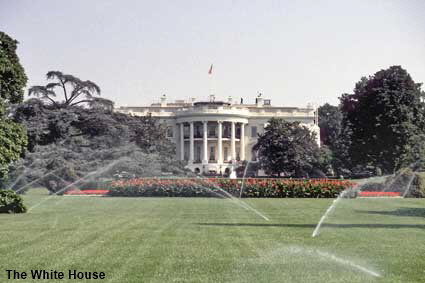
White House & Executive Offices
The White House north facade from Pennsylvania Avenue
This is a more recent photograph (from the Obama era) of front of the White House facing Pennsylvania Avenue, where visiting Heads of State arrive to see the President. The President’s official office, the Oval Office, is in the West Wing which is out of the picture to the right. In the days of relaxed security prior to the 9/11 attacks you could queue up for daily tours of parts of the White House. Post 9/11 security ended open access and now US citizens have to request a tour through their Member of Congress at least 30 days in advance. Overseas visitors can visit the White House but have to get their Embassy in Washington DC help with the arrangements.
Treasury Building from Pennsylvania Avenue
Much as in Britain the Chancellor of the Exchequer lives next door to the Prime Minister, in Washington DC the US Treasury is next door to the White House. The original Treasury building was partially destroyed by fire in 1801, and then burned by the British in 1814. The current Treasury was designed by White House architect James Hoban, one of four identical buildings located on lots adjacent to the White House, housing the four original departments of the U.S. Government: the State Department, the War Department, the Navy Department, and the Treasury Department. In front of the Treasury is a statue of Albert Gallatin, the longest-serving U.S. Secretary of the Treasury
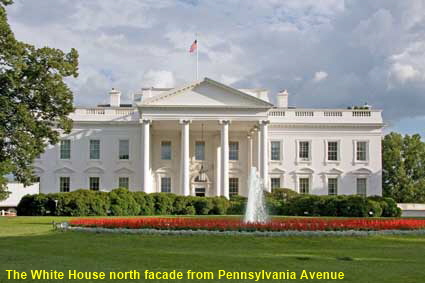
Click on Minimap to navigate
Home > US States > Midatlantic USA > Washington DC >
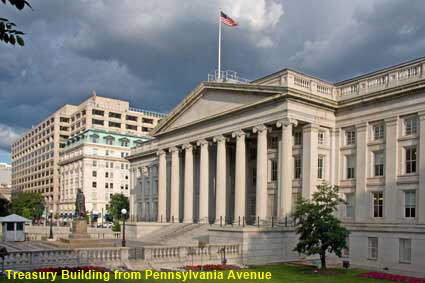


To move forwards or backwards through the Washington DC trail click the arrows above, or select your next destination on the Minimap.
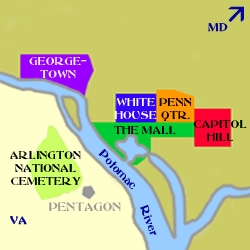
DLU100619
Jackson Statue, & White House from Lafayette Square
While the back of the White House looks out over the Ellipse and the Washington Monument, the front looks out over Pennsylvania Avenue and Lafayette Square. The square is named after French aristocrat and military officer the Marquis de Lafayette who was a general in the American Revolutionary War. The equestrian statue in the centre of the square is of of President Andrew Jackson. It was cast in bronze by Clark Mills and erected in the square in 1853. A statue of Lafayette can be found in one corner of the square and the remaining corners have statues of other overseas revolutionary heroes. The square is home to a long standing protest against nuclear weapons.
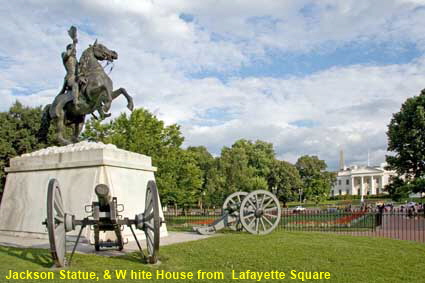
Dwight D Eisenhower Executive Office from Pennsylvania Avenue
The original executive offices grew too small so the War Office building next to the White House was demolished and between 1871 and 1888 an new building was constructed to house the State, War and Navy Departments. It was designed by Supervising Architect of the Treasury Alfred Mullett in the French Second Empire-style. When it opened it was the largest office building in Washington D.C. By the late 1930s the original departments had moved out and the building became known as the Old Executive Office Building. A public outcry saved it from demolition in the 1950s. Renamed the Dwight D Eisenhower Executive Office it now houses a number of agencies of the President’s Executive Office and the Vice President's Ceremonial Office.
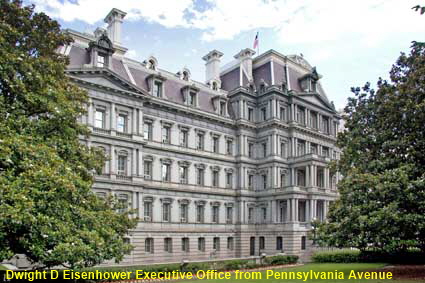

© Mike Elsden 1981 - 2025
The contents of this page may not be reproduced in full or in part without permission